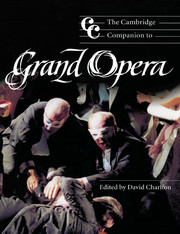Book contents
8 - Directing grand opera: Rienzi and Guillaume Tell at the Vienna State Opera
from Part II - Revaluation and the twenty-first century
Published online by Cambridge University Press: 28 November 2011
Summary
Directing grand opera in the early twenty-first century is somewhat like being required to remake Ben Hur for an art-house budget. The essence of the aesthetic of grand opera was rooted in the fact that it was a commercial enterprise, designed with a lavish sense of the spectacular to flatter the newly rich bourgeoisie, for whom the pompous splendours of theatres like the Palais Garnier were created. It took the aristocratic art form par excellence, transformed it into a celebration of conspicuous consumption, and trumpeted the dominance of new money in its natural home at the heart of the newly industrialised city. Garnier's fantastic building, and the construction of the Avenue de l'Opéra, remind us today of the luxury that clothed grand opera during and after the Second Empire, though it is revealing that the home of opera, once an adjunct of the Court, has now become a traffic island.
The parallels with Hollywood are apt, and especially the Hollywood of escapist fantasy and spectacle of the 1930s and 1940s. It is significant for instance that the main achievements of grand opera are scenic and structural as much as musical. There are probably only two true musical masterpieces which can be correctly attributed to the genre – Guillaume Tell and Don Carlos – although it is clear that neither Les Troyens nor even the libretto of Götterdämmerung is free of its influence.
- Type
- Chapter
- Information
- The Cambridge Companion to Grand Opera , pp. 129 - 146Publisher: Cambridge University PressPrint publication year: 2003
- 1
- Cited by



